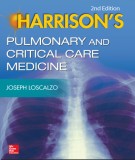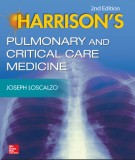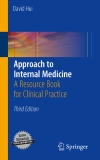
Harrison's pulmonary
-
(BQ) Continued part 1, part 2 of the document Harrison's pulmonary and critical care medicine presents the following contents: Common critical illnesses and syndromes, disorders complicating critical illnesses and their management, laboratory values of clinical importance.
 333p
333p  thangnamvoiva2
thangnamvoiva2
 25-06-2016
25-06-2016
 53
53
 4
4
 Download
Download
-
(BQ) Part 1 of the document Harrison's pulmonary and critical care medicine presents the following contents: Diagnosis of respiratory disorders, diseases of the respiratory system, general approach to the critically ill patient.
 287p
287p  thangnamvoiva2
thangnamvoiva2
 25-06-2016
25-06-2016
 53
53
 3
3
 Download
Download
-
The first edition of Harrison’s Principles of Internal Medicine was published more than half a century ago. Over the decades, this textbook has evolved to reflect the continuing advances in the field of internal medicine and to meet the growing information base required of medical students and clinical practitioners. The users of this sixteenth edition of Harrison’s will not even have to open the volume to see that it marks a transition point in the book’s history. The new cover is only the most obvious indication of a new direction for Harrison’s.
 480p
480p  hyperion75
hyperion75
 21-01-2013
21-01-2013
 85
85
 14
14
 Download
Download
-
Respiratory Tract Infections Respiratory tract infections caused by S. aureus occur in selected clinical settings. S. aureus is a cause of serious infections in newborns and infants; these infections present as shortness of breath, fever, and respiratory failure. Chest x-ray may reveal pneumatoceles (shaggy, thin-walled cavities). Pneumothorax and empyema are recognized complications of this infection. In adults, nosocomial S. aureus pulmonary infections are commonly seen in intubated patients in intensive care units.
 5p
5p  colgate_colgate
colgate_colgate
 21-12-2010
21-12-2010
 74
74
 2
2
 Download
Download
-
Nonimmunologic Mechanisms Nonimmunologic mechanisms that protect against pneumonia include filtration of air as it passes through the nasopharynx, the glottal reflex, laryngeal closure, the cough reflex, clearance of organisms from the lower airways by ciliated cells, and ingestion by pulmonary macrophages and PMNs of small bacterial inocula that manage to reach alveolar spaces. Respiratory virus infection, chronic pulmonary disease, or heart failure compromises these mechanisms, predisposing to the development of pneumococcal pneumonia.
 5p
5p  colgate_colgate
colgate_colgate
 21-12-2010
21-12-2010
 68
68
 2
2
 Download
Download
-
Pathogenesis Hib strains cause systemic disease by invasion and hematogenous spread from the respiratory tract to distant sites such as the meninges, bones, and joints. The type b polysaccharide capsule is an important virulence factor affecting the bacterium's ability to avoid opsonization and cause systemic disease. Nontypable strains cause disease by local invasion of mucosal surfaces. Otitis media results when bacteria reach the middle ear by way of the eustachian tube. Adults with chronic bronchitis experience recurrent lower respiratory tract infection due to nontypable strains.
 5p
5p  colgate_colgate
colgate_colgate
 21-12-2010
21-12-2010
 78
78
 5
5
 Download
Download
-
Kidney transplant recipients are also subject to infections with other intracellular organisms. These patients may develop pulmonary infections with Nocardia, Aspergillus, and Mucor as well as infections with other pathogens in which the T cell/macrophage axis plays an important role. In patients without IV catheters, L. monocytogenes is a common cause of bacteremia ≥1 month after renal transplantation and should be seriously considered in renal transplant recipients presenting with fever and headache.
 5p
5p  chubebandiem
chubebandiem
 14-12-2010
14-12-2010
 86
86
 3
3
 Download
Download
-
Inhalational Anthrax (See also Chap. 214) Inhalational anthrax, the most severe form of disease caused by Bacillus anthracis, had not been reported in the United States for more than 25 years until the recent use of this organism as an agent of bioterrorism (Chap. 214). Patients presented with malaise, fever, cough, nausea, drenching sweats, shortness of breath, and headache. Rhinorrhea was unusual. All patients had abnormal chest roentgenograms at presentation. Pulmonary infiltrates, mediastinal widening, and pleural effusions were the most common findings.
 8p
8p  thanhongan
thanhongan
 07-12-2010
07-12-2010
 68
68
 2
2
 Download
Download
-
Clinical Presentation Symptoms The clinical onset of the chronic phase is generally insidious. Accordingly, some patients are diagnosed while still asymptomatic, during health-screening tests; other patients present with fatigue, malaise, and weight loss or have symptoms resulting from splenic enlargement, such as early satiety and left upper quadrant pain or mass. Less common are features related to granulocyte or platelet dysfunction, such as infections, thrombosis, or bleeding.
 5p
5p  thanhongan
thanhongan
 07-12-2010
07-12-2010
 66
66
 3
3
 Download
Download
-
Treatment of Promyelocytic Leukemia Tretinoin is an oral drug that induces the differentiation of leukemic cells bearing the t(15;17). APL is responsive to cytarabine and daunorubicin, but about 10% of patients treated with these drugs die from DIC induced by the release of granule components by dying tumor cells. Tretinoin does not produce DIC but produces another complication called the retinoic acid syndrome. Occurring within the first 3 weeks of treatment, it is characterized by fever, dyspnea, chest pain, pulmonary infiltrates, pleural and pericardial effusions, and hypoxia.
 5p
5p  thanhongan
thanhongan
 07-12-2010
07-12-2010
 58
58
 2
2
 Download
Download
-
The hematologic toxicity of high-dose cytarabine-based induction regimens has typically been greater than that associated with 7 and 3 regimens. Toxicity with high-dose cytarabine includes myelosuppression, pulmonary toxicity, and significant and occasionally irreversible cerebellar toxicity. All patients treated with high-dose cytarabine must be closely monitored for cerebellar toxicity. Full cerebellar testing should be performed before each dose, and further high-dose cytarabine should be withheld if evidence of cerebellar toxicity develops.
 5p
5p  thanhongan
thanhongan
 07-12-2010
07-12-2010
 61
61
 3
3
 Download
Download
-
Table 111-3 Long-Term Treatment with Vitamin K Antagonists for Deep Vein Thrombosis (DVT) and Pulmonary Embolism (PE) Patient Categories Duration, months Comments First episode of DVT or PE secondary to a transient (reversible) risk factor 3 Recommendation applies to both proximal and calf vein thrombosis First episode of 6–12 Continuation of idiopathic DVT or PE anticoagulant therapy after 6–12 months may be considered First episode of DVT 6–12 Continuation of or PE with a documented thrombophilic abnormality anticoagulant therapy after 6–12 months may be considered ...
 6p
6p  thanhongan
thanhongan
 07-12-2010
07-12-2010
 60
60
 4
4
 Download
Download
-
Harrison's Internal Medicine Chapter 111. Venous Thrombosis Venous Thrombosis: Introduction Venous thrombosis is the result of occlusive clot formation in the veins. It occurs mainly in the deep veins of the leg (deep vein thrombosis, DVT), from which parts of the clot frequently embolize to the lungs (pulmonary embolism, PE). Fewer than 5% of all venous thromboses occur at other sites (see "Thrombosis at Rare Sites," and "Superficial Thrombophlebitis," below).
 6p
6p  thanhongan
thanhongan
 07-12-2010
07-12-2010
 77
77
 6
6
 Download
Download
-
Acute chest syndrome is a medical emergency that may require management in an intensive care unit. Hydration should be monitored carefully to avoid the development of pulmonary edema, and oxygen therapy should be especially vigorous for protection of arterial saturation. Diagnostic evaluation for pneumonia and pulmonary embolism should be especially thorough, since these may occur with atypical symptoms.
 6p
6p  thanhongan
thanhongan
 07-12-2010
07-12-2010
 76
76
 3
3
 Download
Download
-
Clinical Manifestations Patients with cancer who develop deep venous thrombosis usually develop swelling or pain in the leg, and physical examination reveals tenderness, warmth, and redness. Patients who present with pulmonary embolism develop dyspnea, chest pain, and syncope, and physical examination shows tachycardia, cyanosis, and hypotension. Some 5% of patients with no history of cancer who have a diagnosis of deep venous thrombosis or pulmonary embolism will have a diagnosis of cancer within 1 year.
 5p
5p  thanhongan
thanhongan
 07-12-2010
07-12-2010
 69
69
 3
3
 Download
Download
-
Postchemotherapy Surgery Resection of residual metastases after the completion of chemotherapy is an integral part of therapy. If the initial histology is nonseminoma and the marker values have normalized, all sites of residual disease should be resected. In general, residual retroperitoneal disease requires a modified bilateral RPLND. Thoracotomy (unilateral or bilateral) and neck dissection are less frequently required to remove residual mediastinal, pulmonary parenchymal, or cervical nodal disease.
 5p
5p  konheokonmummim
konheokonmummim
 03-12-2010
03-12-2010
 82
82
 5
5
 Download
Download
-
Bronchial Adenomas Bronchial adenomas (80% are central) are slow-growing endobronchial lesions; they represent 50% of all benign pulmonary neoplasms. About 80–90% are carcinoids, 10–15% are adenocystic tumors (or cylindromas), and 2–3% are mucoepidermoid tumors. Adenomas present in patients 15–60 years old (average age 45) as endobronchial lesions and are often symptomatic for several years. Patients may have a chronic cough, recurrent hemoptysis, or obstruction with atelectasis, lobar collapse, or pneumonitis and abscess formation.
 5p
5p  konheokonmummim
konheokonmummim
 03-12-2010
03-12-2010
 236
236
 2
2
 Download
Download
-
Superior Sulcus or Pancoast Tumors Non-small cell carcinomas of the superior pulmonary sulcus producing Pancoast's syndrome appear to behave differently than lung cancers at other sites and are usually treated with combined radiotherapy and surgery. Patients with these carcinomas should have the usual preoperative staging procedures, including mediastinoscopy and CT and PET scans, to determine tumor extent and a neurologic examination (and sometimes nerve conduction studies) to document involvement or impingement of nerves in the region.
 5p
5p  konheokonmummim
konheokonmummim
 03-12-2010
03-12-2010
 77
77
 6
6
 Download
Download
-
Non-Small Cell Lung Cancer NSCLC Stages I and II Surgery In patients with NSCLC stages IA, IB, IIA and IIB (Table 85-2) who can tolerate operation, the treatment of choice is pulmonary resection. If a complete resection is possible, the 5-year survival rate for N0 disease is about 60–80%, depending on the size of the tumor. The 5-year survival drops to about 50% when N1 (hilar node involvement) disease is present. The extent of resection is a matter of surgical judgment based on findings at exploration.
 5p
5p  konheokonmummim
konheokonmummim
 03-12-2010
03-12-2010
 85
85
 6
6
 Download
Download
-
Brain Masses Mass lesions of the brain most often present as headache with or without fever or neurologic abnormalities. Infections associated with mass lesions may be caused by bacteria (particularly Nocardia), fungi (particularly Cryptococcus or Aspergillus), or parasites (Toxoplasma). Epstein-Barr virus (EBV)–associated lymphoproliferative disease may also present as single or multiple mass lesions of the brain. A biopsy may be required for a definitive diagnosis. Pulmonary Infections Pneumonia (Chap.
 5p
5p  konheokonmummim
konheokonmummim
 03-12-2010
03-12-2010
 72
72
 3
3
 Download
Download
CHỦ ĐỀ BẠN MUỐN TÌM
































